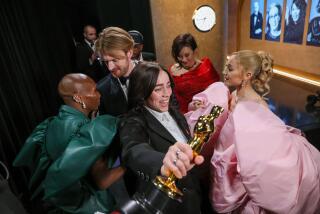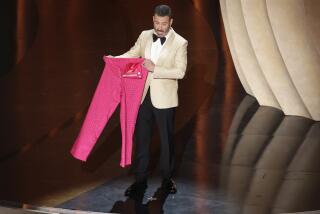Classic Hollywood: A week of honors for Douglas Trumbull
Visual effects visionary, director and producer Douglas Trumbull has a “broad” philosophy of film. He believes that everything in a movie is, in essence, a special effect.
“Movies are all about illusions, whether it is makeup or wardrobe or some location or being in a period of time or being on an alien planet,” says Trumbull, 69.
Trumbull has created some of the screen’s greatest illusions in such seminal sci-fi films as Stanley Kubrick’s 1968 masterwork “2001: A Space Odyssey,” his own 1972 cult classic “Silent Running” and Steven Spielberg’s 1977 “Close Encounters of the Third Kind.” His work spans more than four decades, most recently on the lengthy beginning-of-life sequence that opens Terrence Malick’s Oscar-nominated “The Tree of Life.”
It’s a big week for Trumbull. On Tuesday at the Visual Effects Society Awards, he will receive the Georges Méliès Award for his contributions to visual effects. On Friday, the UCLA Film & Television Archive is welcoming Trumbull to the Billy Wilder Theater for a screening and conversation about “Silent Running.” And on Saturday at the film academy’s Scientific and Technical Awards at the Beverly Wilshire, he will be receiving the Gordon E. Sawyer Award, presented to “an individual in the motion picture industry whose technological contributions have brought credit to the industry.”
“It’s getting to be a pretty busy time for me,” Trumbull says.
Throughout his illustrious career, Trumbull has created, developed and made improvements on numerous special-effects techniques including slit-scan photography, which he created for the famous “Star Gate” sequence in “2001”; process photography; miniature composition; and motion control photography. In 1992, he won a Scientific and Engineering Award from the academy as part of the design team of the CP-65 Showscan Camera System for 65-millimeter movie photography, which has yet to be used on a feature film.
It was “2001” that put Trumbull on the map. Kubrick hired Con Pederson of Graphic Films in Los Angeles to work on the effects for “2001.” Trumbull, who was working for Graphic, got Kubrick’s number from Pederson and called him for a job. Kubrick hired the plucky young man.
“He gave me incredible freedom,” recalls Trumbull, talking by phone from his home in the Berkshires in Massachusetts. “Stanley Kubrick was a very interesting intellect. I think he put a lot of people off, but he didn’t me at all. I had an incredibly good, supportive and positive relationship with Stanley because I really admired that he was trying to break new ground and do something new.
“Even though I was kind of young, I was the right guy for the job. I was willing to think outside the box. I didn’t have any old habits. We did a lot of unusual photographic things in support of that movie.”
Among the innovations was the slit-screen machine. “The shutter of the camera remains open for about a minute,” he explains. “We moved various mechanically controlled lights in front of the camera to create what I call a controlled blur. I built this big machine to control very complicated patterns of light in front of the camera.”
For Trumbull, the experience was so inspiring, “I thought, ‘Count me in if this is the movie business.’ Then I became kind of disappointed that the giant palette of the giant screen of Cinerama went away. I was destined to make regular movies for a long time but still trying to break new ground.”
Though “Silent Running” wasn’t a box-office hit, Trumbull received good reviews for the 1972 film, an environmentally themed sci-fi drama set in the future when all plant life has been destroyed on Earth. “I ended up directing it by default,” he says. “I was developing the story and the project. It was obviously very unusual to make a movie that involved a lot of what we call front projection, which is what we used on ‘2001,’ and a lot of visual effects and animation techniques. They said, ‘Who can make this movie?’ and I said, ‘I’ll do it.’
He’s not a fan of computerized special effects — he still likes to use miniatures and photographic effects because they produce surprising results as they did in “Tree of Life.” “You create the opportunity for the unexpected to occur, which was what Terry was after.”
Trumbull is working on a new approach to make science-fiction films that he hopes will be less expensive and more organic to the filmmaking process using high-speed photography. “What happens is that the image on the screen becomes like a window onto reality,” he says.
More to Read
The biggest entertainment stories
Get our big stories about Hollywood, film, television, music, arts, culture and more right in your inbox as soon as they publish.
You may occasionally receive promotional content from the Los Angeles Times.











